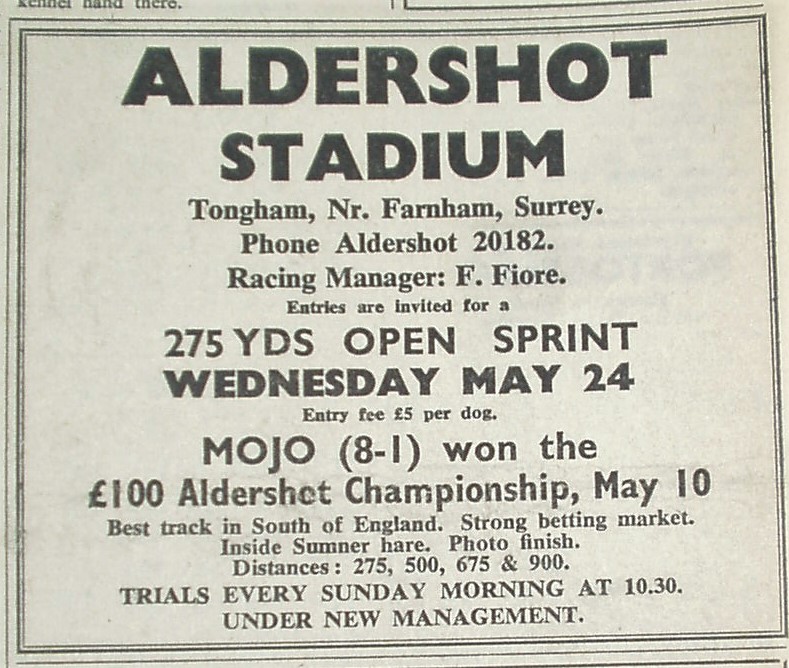Oxenden Road, Tongham, Aldershot, Hampshire.
POSTCODE———————————-GU10 1AG
LOCATED————————————-The village of Tongham lies one mile east of Aldershot town centre, with the stadium situated just east of the A331 bypass, about and half a mile south of the A323 roundabout interchange.
ORIGINAL SITE——————————Farm grazing land, but used during the 1930’s as a grass speedway track and during the mid 1930’s a Whippet/Greyhound track.
DATE CONSTRUCTED——————–Early 1930’s.
DATE VENUE OPENED——————-Early 1930’s.
Meaning other sports may have taken place prior to the arrival of Greyhound Racing.
FIRST MEETING—————————–Early 1930’s.
Greyhound Racing only.
LICENSED OR INDEPENDENT———-Independent
All venues covered would have to be licensed with the government, licensed suggested in this section would refer to tracks operating under NGRC Rules.
INSIDE OR OUTSIDE HARE TYPE——Inside Sumner.
Please note that the Electric Hare suggested is only a guidance, and would have been in operation for a certain amount of time at this venue. Although it is not necessarily guaranteed that it was operational all the time, as other types of lure may have been used and updated as time progressed.
DISTANCES———————————–275, 500 and 675 yards.
Please note that most racing venues distances had become varied throughout the years, the ones given above were at once point set and offers only a guidance to the track size.
CIRCUMFERENCE—————————400 yards.
Please note that alterations at most racing venues throughout its existence would see that the circumference of the track would vary, the one shown above offers only a guidance to the track size.
BIG RACE NAMES—————————The Aldershot Derby, The Southern Championship and an intertrack challenge match against Weymouth Greyhound Stadium annually.
STADIUM SHARED WITH—————–Speedway and Stock Car Racing and other minor motor sports events.
LAST MEETING——————————October 30th 1992.
Greyhound Racing only.
STADIUM CLOSURE DATE—————November 1992 for Stock Car Racing.
Meaning other sports may have taken place after Greyhound Racing had ceased.
STADIUM DEMOLITION——————December 1992.
BUILT ON SITE——————————The busy A331 Bypass an its access road now covers the site. This section of road was constructed during 1993.
In some cases, structure’s that originally covered the venue after the stadium had been demolished, may have been themselves demolished too, so the one described is more likely to be the one which now presently covers the site.
EVIDENCE LEFT TODAY——————Mounds of rubble now overgrown with weeds atre still evident amongst a section of unused land.
FURTHER COMMENTS——————-None



















The village of Tongham is found roughly one mile east of Aldershot town centre, positioned on the Surrey and North East Hampshire border. The village is more recognised as being the home to Surrey’s largest brewery, The Hog’s Back Brewery, but also was once the home to Aldershot Greyhound Stadium.
The original site had been nothing more than grazing land, but there is evidence that the land may have been used for Motor Cycle Grass Track Racing during the early 1930’s. Although it is yet to prove, but it is thought that greyhound racing also took place on the site during the early 1930’s, with a track having been constructed on a narrow section of land, which had created a track with long straights and two tight bend’s, with the Southern bend becoming much tighter than the other. But it wasn’t until late 1949 that a speedway track was laid within the infield of the greyhound track, which again was an unusual pear shaped speedway circuit, ready for its first meeting on the 10th of April 1950.
The Aldershot venue became one of only a handful of flapping tracks that operated south of London, in an area mainly dominated by NGRC controlled tracks. Early distances were run over 275, 500 and 675 yards, before eventually switching to the metric versions of 254, 462 and 626 metres, with regular six dog racing chasing an inside Sumner type hare. Like most other tracks it promoted big race events such as The Southern Championship, The Aldershot Derby and the occasional Inter-track Challenge, normally against Aldershot’s nearest rivals Weymouth.
Speedway ceased during 1960, a period that saw the cinder track replaced by a tarmac one, as Stock Car Racing began to feature at the stadium. This new venture would continue for the next thirty years or so, being staged regularly right up until the stadiums closure. By the end of the 1980’s, it was announced that plans had been passed for the construction of a new bypass that pass close by to the stadium, sending the alarm bells ringing amongst its patrons, knowing that the stadium lay directly in the pathway of the new road. But what didn’t help the cause was that Greyhound Racing had been running at a financial loss for a good number of years, and the books had only just been balanced by the slight profit margin made by Stock Car events.
It came as no surprise when it was announced that the stadium had been sold to the council under the compulsory purchase order scheme. Aldershot’s final meeting came on the 30th of October 1992, and became the last flapping track to stage greyhound racing south of the City of London.
The final Stock Car meeting came on the 21st of November 1992, and within a month of the stadiums closure, the Bull Dozers moved in to level the land. Construction of the new A331 Bypass and a slip road began in December 1993, seeing most of the site being swallowed up by the new project. Fortunately, a small section of the site did survive, tucked in at the rear of the houses on Phillips Close, although the land comes across as nothing more than over grown vegetation, it still hides the stadium’s evidence, with mounds of rubble here and there, presumably from demolished outbuildings that once covered the site.
A photograph or memorabilia for this track is required for this page, if you can help please contact me.

Recent Comments